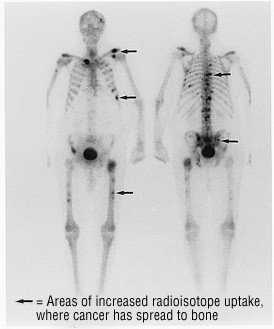The originating document has been archived. We cannot confirm the completeness, accuracy, or currency of the content.
Bone scan
Medically reviewed by Drugs.com. Last updated on Feb 3, 2025.
What is a Bone scan?

A bone scan uses radiation to make images showing areas of bone where cells are unusually active. Unusually active cells can indicate cancer, bone trauma, infection or other disorders.
First, a radioactive chemical called an isotope is injected into a vein. The isotope enters the bloodstream and travels to the bones, where it emits gamma rays, which are similar to X-rays. A gamma camera can detect gamma rays. A computer analyzes the rays and forms an image (or scan) of the bones. Areas with potential problems send out more intense rays and appear as bright spots on the scan.
|
|
A bone scan is painless, except for a mild skin prick to inject the isotope. It takes about three hours for the isotope to travel to the bones. During this time, you usually can leave the facility and return for the scan later, which generally takes about an hour.
What it's used for
A bone scan commonly is used to check for signs that cancer has spread (metastasized) to the bones from another site in the body, such as the breast or prostate. Bone scans also can check for cancers that start in the bones. Bone scans also can check for noncancerous problems, including infections of the bones or joints and bone fractures that may be hidden or not easily diagnosed.
Preparation
Since the levels of radiation used in a bone scan could cause problems for an unborn child, tell your doctor if you are pregnant or if there is a possibility that you might be pregnant.
Before your bone scan, you will need to drink several glasses of water to help flush the isotope through your body. You also will need to empty your bladder before scanning starts. This helps produce clearer pictures.
How it's done
Usually, a bone scan is an outpatient test, conducted in a test facility or hospital. The isotope will be injected into one of your veins, usually in your arm. Because it takes about three hours for the isotope to travel to your bones, many test centers allow patients to leave for a couple of hours and return later. When you return, you will lie in various positions on a table while the camera scans your body. After the procedure, you can resume your normal activities.
Follow-up
Results of your bone scan usually will be available in a day or two. Ask your doctor about how you will be notified of the results.
Risks
The isotopes used in a bone scan are safe and leave the body quickly. The level of radiation involved is lower than in some conventional X-rays. Although it is possible to get an overdose of the isotope, this is very rare.
Some pediatric experts believe that the radiation used in a bone scan is too high for children, so they recommend a bone scan only when one is absolutely necessary.
When to call a professional
Call your doctor if you have pain, redness or swelling at the injection site.
Additional info
National Institutes of Health (NIH)
https://www.nih.gov/
Further information
Always consult your healthcare provider to ensure the information displayed on this page applies to your personal circumstances.

